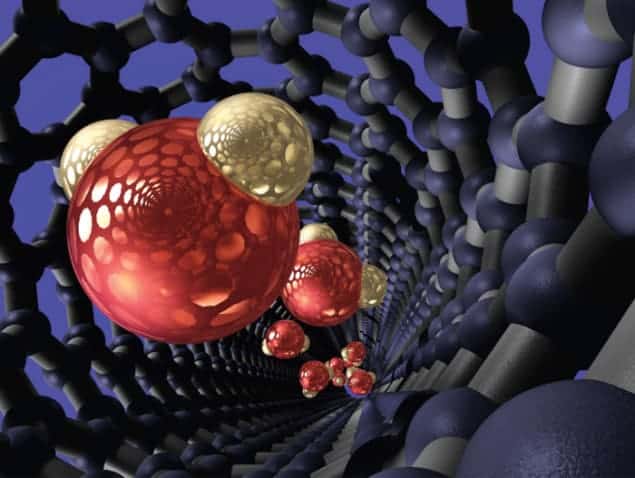Using nanotechnology to teach ethics has its pros and cons, finds Robert P Crease

A colleague at Stony Brook who teaches an online engineering course recently asked me to help students acquire what the syllabus calls “an understanding of professional and ethical responsibility”. Deciding to use nanotechnology as a case study, I created a video about engineering ethics, got the students to read about nanotechnology and then asked them to write a piece on an issue involving “nanoethics”.
Science and engineering students, I have found, generally regard ethics training as a distraction. If they must have it, they want brief, clear instructions on how to identify and solve ethical problems. Unfortunately, ethics doesn’t lend itself to that. Instead, it involves the murkier process of learning how to become sensitive to aspects of a situation that you tend to neglect either because they make you uncomfortable or because you just don’t see them.
The three Is
More specifically, science and engineering students tend to find ethics discussions ineffectual, impossible and intrusive – reasons that I think of as the “three Is”. Ineffectual, because the students see themselves as working on something whose applications – where the ethics is – are somebody else’s business. Impossible, because how can you expect to envision consequences of a new discovery or technology when it doesn’t even exist yet? Intrusive, because students can tend to think that ethical inquiry involves scientifically illiterate outsiders trying to set limits on research when scientists should be free to explore where research takes them.
To set the stage, I had the students read an article from 2005 by the science historian W Patrick McCray entitled “Will small be beautiful? Making policies for our nanotech future” (History and Technology 21 177). This article discusses the creation of the US National Nanotechnology Initiative (NNI) in 2000. McCray begins by quoting a senior adviser at the US National Science Foundation to the effect that the NNI brought about a “phase transition” so that “what had once been perceived as blue sky research…was now being seen as the key technology of the 21st century”.
McCray then discusses the rhetoric used to marshal public and congressional support for this phase transition. The Nobel prize-winning physicist Horst Störmer, for instance, promised that nanotechnology would provide the tools “to play with the ultimate toy box of nature”, noting that “the possibilities to create new things appear endless”. Other scientists argued that nanotechnology could “change the nature of almost every human-made object” and “alter our comprehension of nature and life” – thereby influencing “societal and international relations” and giving rise to a new world called the “nanocosm”.
The nanocosm was promoted with utopian visions that promised industrial competitiveness, medical breakthroughs and even immortality. Some people did make dystopian suggestions of dangers to human health and security – warning of the possibility of disasters that would turn ecosystems into “grey goo” – but the utopian rhetoric was instrumental in creating the excitement that led to the NNI.
McCray’s article makes it easy to counter the first two of the three Is. First, he makes clear that nanotechnology – like much science – intertwines scientific and visionary aspects, both for scientists who do it and for governments that fund it. The potential applications of nanotechnology are usually quite obvious, which is why discussing nano-ethics is in no way an ineffectual exercise. Indeed, nanotechnology perfectly illustrates the “linear-model” fallacy referred to by science-policy analysts, which is that science always begins in the lab detached from a social context and only then do people think about applications. As for the idea that ethics discussions are impossible, the likelihood of specific transformative social impacts was clear to nanotechnology’s researchers and funders from the start, meaning that there are plenty of practical examples to pick from.
The third I – the assumption that ethical inquiry is intrusive to research – is harder to dispel. It springs from the misconception that ethics consists of rules that ethicists dream up. But ethics actually springs from values internal to the everyday practice of science and engineering, such as a desire for openness and avoiding harm. Ethical conflicts arise from clashes between those internal values and the desire of individuals or groups to advance their self-interest. Ethicists do not invent those values, but clarify why they may be compromised and how to head off temptations to do so.
I found that using nanotechnology to teach ethics has limits. For one thing, it creates the illusion that nanotechnology involves a special kind of ethics rather than being a new context for familiar ethical issues, an illusion that has been promoted by numerous books and websites on nanoethics. But as Paul Litton, a professor at the University of Missouri law school, notes in an essay entitled “‘Nanoethics’? What’s new?” (Hastings Center Report 37 22), “None of the ethical concerns associated with nanotechnology is unprecedented and none raises novel ethical issues or demands new ethical principles.” What nanotechnology does, Litton writes, is give us new contexts in which to weigh and balance reasons related to our long-held values: “autonomy, beneficence, fairness, efficiency and environmental preservation”.
The critical point
One student told me that he found the entire exercise frustrating. “I prefer calculus,” he wrote, for “there is always a right and a wrong answer.” People who go into science and engineering, after all, are drawn to problems with exact answers, which ethics does not have. Still, he admitted to being excited enough about nanotechnology to read about its ethical issues.
That illustrated the upside of using nanotechnology to teach ethics. Teaching ethics to students in the middle of a science and engineering class requires delivering a jolt of excitement and the sense of something novel – and discussing nanotechnology delivered. It may pose the same old issues, but served to consolidate their interest long enough to get students to make the phase transition needed to follow through on the readings.
- The latest Physics World Focus on Nanotechnology is now out in print and digital formats



